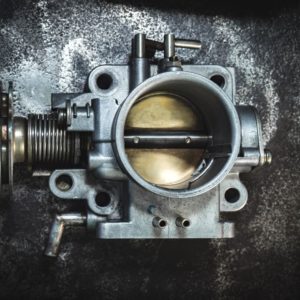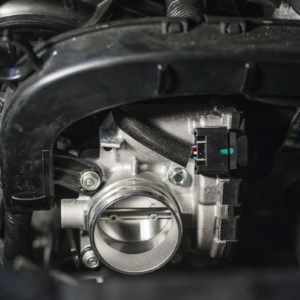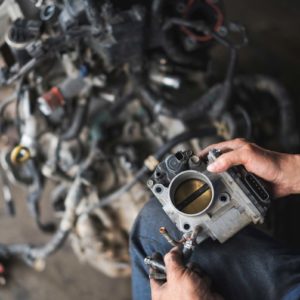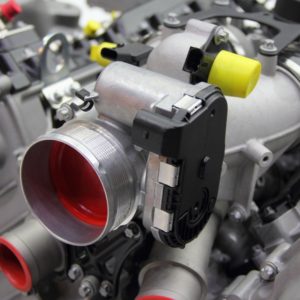The throttle body regulates the air that enters your vehicle’s engine. From a simple cable-operated mechanism, modern vehicles are now equipped with what we call electronic throttle control (ETC) systems. One crucial component of this system is the throttle actuator.
What Does a Throttle Actuator Do?
A throttle actuator is attached to the throttle plate shaft of your vehicle. It is controlled by the powertrain control module (PCM) or electronic throttle control module. An H-bridge circuit receives a bidirectional pulse-width electronic signal from the module. It operates based on data from the accelerator pedal position (APP) sensor and the throttle position sensors. This one minute video illustrates how an H-bridge operates:
The throttle actuator is usually a DC motor that acts as a servo motor. A servo motor is a self-contained electrical device that rotates machine parts precisely and efficiently. The DC motor operates a set of gears that gives the motor tremendous torque. It both closes and opens the throttle plate, even though there’s a spring that holds the plate in its default (closed) position when the throttle body isn’t powered (engine off, key off).
The DC motor operates a set of gears that gives the motor tremendous torque. It both closes and opens the throttle plate, even though there’s a spring that holds the plate in its default (closed) position when the throttle body isn’t powered (engine off, key off).
– Richard McCuistian, ASE Certified Master Automobile Technician
More on Electronic Throttle Systems
To fully understand the role and importance of the actuator, let’s discuss the electronic throttle system’s basic operation.
The throttle assembly includes a DC actuator, a throttle plate, dual throttle position sensors, and springs to hold the throttle plate in a default location. This assembly is usually located between the air filter and the intake manifold.
When you depress the gas pedal, the plate in your throttle body assembly should move at an angle to allow more air into your engine. More air in the engine equals more fuel and more power. The PCM adjusts the position of the plate based on the data input sent by the accelerator pedal position sensor (APP) and the two throttle position sensors (TPS). This whole process of opening and closing the valve won’t happen without a DC motor or throttle actuator.
Signs of a Bad ETC Actuator
Your vehicle may go into “limp mode” or “fail-safe” mode once your throttle actuator fails. This mode will allow you to drive your ride slowly to the nearest auto repair shop or a safe place without damaging your engine.
Once the vehicle is in limp mode, your ride’s engine speed will be limited to its default speed of about 1200 to 1600 RPM. You’ll also experience slow pedal response and the cruise control system may be disabled.

A bad actuator may also trigger the ETC warning light on your dash. This light may appear differently on your dash depending on the specific vehicle you own. For example, on General Motors (GM) vehicles, the reduced power lamp may illuminate. Meanwhile, the warning light should appear as a wrench symbol on the dashboard of Ford vehicles.

Diagnosing a Bad Throttle Actuator
Aside from a failed actuator, throttle spring failure and TP sensor malfunction can also cause your vehicle to go into fail-safe mode. It can be hard to pinpoint which part of the throttle assembly is failing especially if you’re not an experienced mechanic.
But if you’re an experienced automotive DIYer who’d want to diagnose the problem yourself, an OBD scan tool will help you have an idea if your vehicle’s issue is related to a faulty actuator. P2110 and P2112 are some examples of DTCs that are related to a bad actuator.
Important reminder from Richard McCuistian, ASE-certified Master Automobile Technician: Although the electronic throttle body has an internal spring designed to close the throttle plate for safety, the PCM triggers the motor and its gears to drive the throttle blade open AND closed. With that in mind, remember the following:
- Don’t ever open the throttle body with your fingers, even with the engine switched off or with the throttle body removed. On some vehicles, this can ruin the throttle body mechanism so that it has to be replaced. Always have an assistant hold the throttle pedal down to open the throttle plate with the key on and the engine off.
- Never clean the throttle body with your fingers; always use a brush, because if the throttle body plate is driven closed (like if the assistant releases the pedal) the throttle body can severely injure your finger. Keep your fingers out of the throttle body at all times.
Bad Throttle Body Symptoms
Fail-safe mode isn’t the only sign that there’s something wrong with your throttle body and its associated components. An issue with the air control valve can cause unstable idle. If you’d like to know more about the signs of a bad throttle body, you can read our blog here.
Clogged Throttle Body
Your throttle system can malfunction because it’s clogged. Dirt or grime build-up in your throttle body can cause engine stalling. Any debris build-up inside your throttle body can disrupt the flow of air into your engine.

There are many do-it-yourself articles online on how to clean your ride’s throttle body. But if you’re not an experienced automotive DIYer, it would be best to take your ride to an auto repair shop. Experts say a throttle body should be cleaned every 75,000 miles.
How Many Throttle Bodies Do Vehicles Have?
A standard car typically has one throttle body. On the other hand, some high-performance vehicles require faster throttle response and are equipped with a set of throttle bodies. This configuration is known as an Individual Throttle Body (ITB) setup.
Other Important Components In Your Throttle Assembly
Aside from the throttle actuator, here are other important components of your throttle assembly:
Throttle Plate
The butterfly valve that regulates the air entering the engine is referred to as the throttle plate. The plate is controlled by a concentric clock spring. When no power is received from the actuator, the spring forces it to close. Similarly, the spring moves to open the throttle plate to the required angle.
Dual Throttle Position Sensor
An ETC system uses two throttle position sensors as a fail-safe measure and for diagnosis. In a nutshell, a throttle position sensor measures the position of the throttle plate and sends this data to the PCM.
How Much Does a Throttle Actuator Replacement Cost?
You can spend anywhere between $400 and $600 for a throttle body replacement. This estimate includes labor costs of around $80 to $120. You’ll also have to consider taxes and other related repairs. Rates may also change depending on where you are located.
The throttle actuator itself can cost you around $110 to $310. The price of the actuator can vary depending on the brand you choose and other inclusions. There are many aftermarket options available online, so you’ll not have a hard time finding a compatible actuator for your ride.
Where To Buy a Replacement Throttle Actuator
Purchasing a replacement throttle actuator for your vehicle is necessary if your current one can no longer be repaired. After all, you’ll want to get your vehicle out of limp mode as soon as possible. For a simple and easy solution, just order a new part from CarParts.com. We have round-the-clock support for all your questions and concerns. If you have any questions, our friendly customer service is ready to assist.
Here at CarParts.com, you’ll find all the detailed fitment information you need to make the correct purchase. Our parts are a guaranteed perfect fit for your vehicle each and every time. That’s just one of the reasons why we offer a straightforward and hassle-free shopping experience right at your fingertips. Check out our catalog today to find the perfect throttle actuator for your vehicle!
Any information provided on this Website is for informational purposes only and is not intended to replace consultation with a professional mechanic. The accuracy and timeliness of the information may change from the time of publication.





























